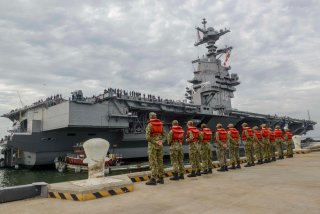Smaller Aircraft Carriers: Is There Any Point?
Smaller carriers are certainly doable. However, they can fly fewer missions and come with fewer defenses.
Here's What You Need to Remember: Carriers that have fewer capabilities would affect how the U.S. wages war, such as relying on carrier-based air support when operating far from U.S. airfields and land-based aircraft.
The bottom line of a new study on U.S. aircraft carriers: you can't get something for nothing.
The Navy can buy smaller, cheaper carriers rather than the $13 billion Ford-class behemoths it is currently constructing, according to a new study by RAND Corporation. But smaller and cheaper means reduced capabilities and could prevent the Navy from fighting in hostile waters or providing the air support for ground operations.
This first appeared earlier and is being reposted due to reader interest.
The RAND study is a public version of a classified study conducted in 2016 at the behest of the U.S. Navy, which was ordered by Congress to examine cheaper options than the Ford-class carriers.
RAND looked at four options:
- The CVN-8X: A slightly stripped-down version of the 100,000-ton Ford-class carriers. It would be powered by forty-year nuclear reactors that couldn't be replaced, rather than the current twenty-five-year reactors on the Fords that can be replaced to extend the life of the ship. It would also be equipped with three rather than four catapults.
Why North Korea's Air Force is Total Junk
- The CVN LX: A 70,000-ton carrier closer to the old Forrestal-class ships of the 1950s, the Navy's first “supercarriers.” They would be propelled by hybrid nuclear-conventional engines, with one reactor instead of the two on the Nimitz- and Ford-class ships. It could still carry a large air wing and would still be more capable than the Nimitz carriers, but it would be slower and less survivable than the Fords, nor could its air wing generate as many sorties.
Why Doesn't America Kill Kim Jong Un?
- The CV LX: A 43,000-ton, conventionally-powered variant of the new America-class amphibious assault ships/helicopter carriers. Lacking catapults, they could only carry twenty-five F-35B and only generate around fifty sorties a day. Without airborne early warning or electronic warfare aircraft, it would "require support from either a legacy carrier or land-based joint assets. It can operate in areas where air defense threats are not significant or in company with a battle force. The CV LX is not the capability of choice as a first on-scene responder because it lacks an integrated air wing and, in particular, lacks AEW and EA [airborne early warning and electronic attack].”
The F-22 Is Getting a New Job: Sniper
- The CV EX: A small, 20,000-ton baby carrier that would be conventionally powered and could only accommodate six to ten short take-off aircraft, similar to the Italian carrier Cavour. The CV EX would be the cheapest option at $2.5 billion a vessel, but RAND estimates that four CV LX carriers would be needed to generate the same capability as a single Ford-class ship. “The CV EX has all the limitations of the CV LX with a much smaller flight deck, fuel, and magazine capacity and would therefore have to be used either as a responder to low-level contingencies or in conjunction with a legacy CVN,” RAND concludes.
RAND was careful not to endorse a particular option. But the report makes clear that less capability is the price tag for lower shipbuilding costs. For example, to launch conventional fixed-wing aircraft such as the F-35C, a carrier must be large enough to have space for catapults and arresting gear. A smaller carrier could launch short take-off F-35Bs and helicopters, but then it wouldn't be able to launch E-2 radar aircraft or EA-18 electronic warfare planes.
In turn, carriers that have fewer capabilities would affect how the U.S. wages war, such as relying on carrier-based air support when operating far from U.S. airfields and land-based aircraft. “It’s true that getting what’s in the Ford-class capability requires Ford-class investment,” Brad Martin, a retired Navy captain and one of the RAND researchers who wrote the study, told TNI. “The alternatives are offered as less costly, but we are clear that there is diminishment in capability that Navy would need to evaluate. Some losses of capability might not be critical—a lower sortie generation rate for example—but others might be much more so.”
Opting for either of the large nuclear carriers described by RAND probably wouldn't result in too drastic a change for the Navy. Not so for the two smaller, conventionally-powered carriers. “The conventionally-powered alternatives we looked at—the two smallest variants—would, if selected as replacements for the Nimitz class as these ships reach service life, significantly impact Navy operational concepts,” Martin said. “This is primarily because they lack the ability to support an integrated air wing. They could generate some portion of the strike and defensive counter-air sorties required in campaign plans, but they would have to rely on some off-ship alternative for other capabilities (airborne early warning and C2 in particular) now provided organically.”
So what's the best option? There isn't one. Either the Navy ends with large carriers that aren't that much different than a Ford, or small carriers with radically less capabilities.
Michael Peck is a contributing writer for the National Interest. He can be found on Twitter and Facebook. This first appeared earlier and is being reposted due to reader interest.
Image: Flickr

